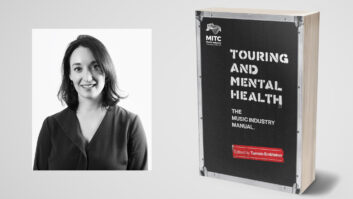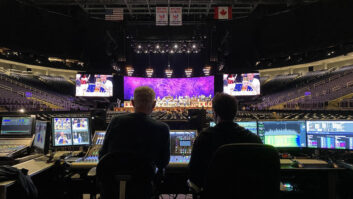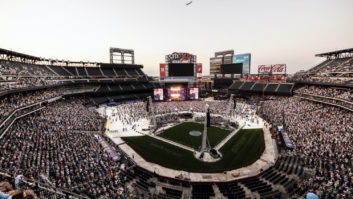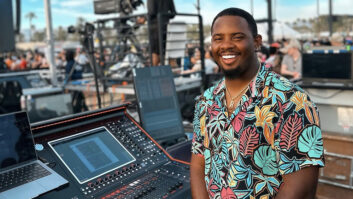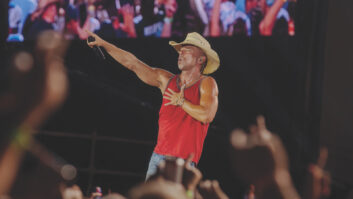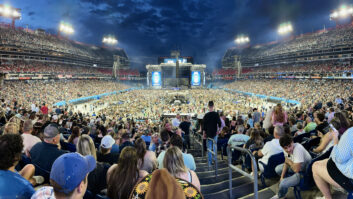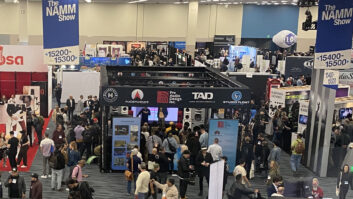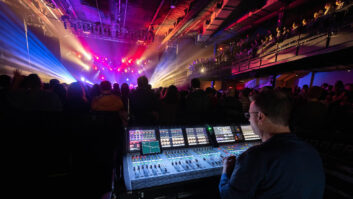A BEAUTIFUL NIGHT WITH ROCK’S REIGNING SUPERSTARS
After picking up three Grammys (Record of the Year, Song of the Year and Best Rock Performance) for their song “Beautiful Day,” on the album All That You Can’t Leave Behind, U2 and support act PJ Harvey embarked on an extensive spring tour. Playing to both the band’s humble past and more recent incarnations as a multimedia extravaganza, the show opens with the house lights on, the band casually taking the stage and greeting the audience. The show’s visual effects then run the gamut from simple to simply awesome.
Mix caught up with The Elevation Tour at Portland’s Rose Garden Arena. Shortly after Bono arrived for soundcheck, he solemnly announced Joey Ramone’s passing away in New York City. He then politely asked how much time he had before PJ Harvey’s check, before leading the group in refinements to the evening’s set, which turned out to be a 160-minute, nonstop marathon of two dozen songs, spanning the band’s quarter-century repertoire.
FLYING ARRAYS IN THE ROUND
The main P.A. is a fully updated Clair Bros. I-4 line array system flown by engineer Tom “Duds” Ford. The show is sold in the round, and two arrays of six enclosures, arranged in 10° increments, cover the back. Each side of the arena is covered by an eight-deep column, and the main left and right system is a 14-box banana with boxes angled at 2°, 5° and 10° covering the long, medium and short throws. Few actual subwoofers are employed in the rig. Clair Bros.’ prototype run of two dozen supplemental I-4B bass cabinets enhance the low end. They are vented, single-18 enclosures that fly immediately adjacent to the array on one side, making it a “chubby banana” and putting all the low end in the air with the rest of the rig. While the rest of the sound system uses Crest Audio 10004 amps, the new I-4Bs are powered with QSC 9.0 amps, which were chosen for their ability to drive multiple low drivers cleanly. The three zones of main I-4 arrays each have their own XTA DP 226 processor, in addition to TC Electronic 1128 programmable EQs, which include the 6032 remote head.
American promoters agreed to this tour’s general admission plan for the arena floor with some hesitation. U2 has not played GA shows in the States since their club days in the early ’80s, though they regularly do so in other parts of the world. Ramps in the shape of the bottom of a heart descend from the stage wings to meet at the center of the arena floor, creating a club gig in the middle of an arena gig. The first 300 GA fans got wrist bands and were able to enjoy the show from inside the ramps.
The area inside the ramps is covered by P-2 speakers on top of ML18 subs under the front of the stage, in addition to a flown three-box P-4 center cluster that is hung overhead. System engineer Joe Ravitch is assisted at FOH by Jason Kirschnick, whose duties include making five copies of each show with a rack of HHB CD recorders, one for each bandmember and one for veteran FOH mixer Joe O’Herlihy, who raves about the recent enhancements to the Clair Bros. P.A. system.
WHERE THE RACKS HAVE NO NAME
O’Herlihy mixes on a Midas XL4. A Yamaha 02R sidecar handles some of the extraneous overflow inputs, such as the Yamaha CP70 electric piano that Bono plays “The Sweetest Thing” on, the audio input for the video of NRA president Charlton Heston that plays before “Bullet” and some of the SPX returns. A double-wide rack houses an armada of outboard processing. Inserts include blue dbx 160SL compressors on vocals, Summit DCL-200 tube compressors for The Edge’s guitar inputs, dbx 160XT compressor/limiters for bass inputs and Drawmer DS201 gates across the toms. Vocal effects include two TC 2290 delays for short and long delays, a Lexicon 480L and an Eventide H3000 D/SE. There are also two Lexicon PCM 70s (one for snare and the other for toms), two SPX-990s with chorus and reverb settings for guitars and two more SPX-1000s for special vocal treatments on certain songs. The SPX-1000 was used frequently on the previous tour for its multi-effects capabilities, and there are a half-dozen spares in O’Herlihy’s FOH work box.
The set is a 5-foot Tait Towers stage, with 7-foot wings and a rear apron that quickly rolls into place and locks together under the lighting and sound rigs. Upstage left, beneath the deck, the monitor mix position is concealed from the audience. There have been some upgrades to the monitor pit since the Pop Mart tour. Twin Paragon monitor consoles are manned by returning U2 veterans Don Garber and Dave Skaff. Due to their mixing blind beneath the left wing of the stage, each meter bridge supports four video monitors, which are fed a split from the onstage video screens. The Paragons eliminate the need for outboard dynamics processing due to the availability of gating and compression on every input. On this tour, they’ve swapped chores, with Skaff mixing for Larry Mullen and Adam Clayton, while Garber mixes ears for Bono and The Edge.
Typical for many bass players, Clayton favors wedge-based monitoring, spending much of the night standing “in the pocket” in front of his rig at the corner of the drum riser, where a single Clair Bros. 12-AM wedge sweetens his world. At the front of the stage, there’s also a pair of Clair Bros. double-12s for him. The rest of the stage is sparsely populated with monitors: A pair of 12-AMs for Bono, a pair of the newer Series II wedges in front of The Edge, and behind Mullen a pair of Clair Bros.’ ML18 single-18 subs add a little “thump” to his hard-wired ear mix. At each end of the backline, a Clair Bros. P-4 is laid on its side, on top of ML18 subs and angled in as sidefill speakers; these arrays are kept in this upstage position to clean up sight lines. At the front of each wing is another double-12, and at each end of the upstage apron a pair of subs and a wedge fill in the back corners. Though the other three musicians are using in-ear monitors, the wedges and fills are provided to cover the stage should someone pop out their in-ears, or in the off-chance that Clayton leaves his pocket.
All of the IEM rigs include the latest dynamic ear-pieces by Future Sonics — a product that Skaff reports has more output and better low end. The two wireless systems are Sennheiser 3056s, and all the mixes employ Aphex Dominators, with a TC Finalizer on Mullen’s mix.
Supplementing the Paragons, an 02R and a Mackie 1604 were used as sidecar mixers for the extensive talkback inputs, as well as the audience mics. A Sennheiser 416 is used at each side of the downstage edge of the wings, and a Shure VP88 is used at the FOH mix position to catch the rear of the arena.
THERE’S NO SUBSTITUTE FOR MOVING AIR
Most of the microphone selection consists of fairly traditional choices. Two of The Edge’s well-worn Vox AC-30 amps are miked with Shure SM56s, as is another in an isolation roadcase, dubbed “Vox-in-a-box.” Only one direct line was taken from his Line 6 Pod, which was used extensively for effects on the new album’s songs. Behind him stood a “rack of the rich and famous,” which held a dizzying array of processing, including several TC Electronic 2290 delays. Bono’s Line 6 Flextone guitar amp was miked with an SM57, as is another Flextone used on the stage-right wing.
Mullen’s kick drum is double-miked with an SM98 and a Beta 52; the snare has a beyerdynamic M 88 on top and a Beta 56 below. Sennheiser MD-421s were employed on the single rack and both floor toms. Audio-Technica 4050s were used as overheads, while AKG 460s were on the hi-hats and beneath the bell of the ride cymbal. A pair of SM57s were Y’ed for the two mounted tambourines, and an SM98 was used for the piccolo snare Mullen plays “Where the Streets Have No Name”.
Niall Slevin, whom I recognized from Mix‘s AC/DC “All Access” (February, 2001), showed me the latest innovation in mic stand hardware. The position of each mic stand was established after the first few shows. With the round base removed, the rest of the Atlas stand screws into adapters that slip into holes drilled in the deck, firmly locking into fittings mounted beneath. Thus, they are almost impossible to knock over. Vocal mics were mostly Shure Beta 58 capsules, with The Edge’s being hard-wired and Bono using a handheld Shure UHF system. On the track “New York, New York,” he trades his handheld for a head-set mic with its transmitter mounted on a hat, allowing him do some theatrical performing on the ramps.
By the time you leave the show, you realize that one of the last great rock bands of our time has raised the bar once again, perhaps not for the last time. Bono’s signature vocal cuts through the complex, full-on, rock ‘n’ roll mix, leaving the audience with a sense of the spectacle that dominated rock shows of decades past.
The show loads out into 14 semis in just under two hours, with the local crew broken down into teams and organized into groups by colored T-shirts. The U2 crew confirms my impression that, as arenas go, the Rose Garden has above-average catering, acoustics and loading docks. My lasting backstage image is of Dave Skaff trying to sort through the half-dozen identical silver Prevost crew buses to find his home.
Mark Frink is Mix‘s sound reinforcement editor.
